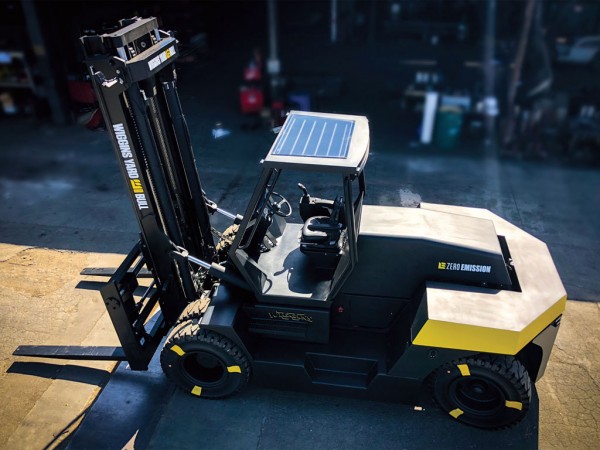While not quite owning the same reputation in marine terminal cargo handling as Taylor, Hyster, Konecranes and other forklift manufacturers attending the annual Breakbulk Show in Houston, Texas, Wiggins Lift Company has a habit of gobbling up the “Lime Light”. Its presence at this year’s Breakbulk Show was no exception.
Wiggins was the first forklift manufacturer to bring a large capacity forklift truck to the show floor at the Breakbulk venue in New Orleans. Each year since, they have continued the tradition and this year’s model was a special 36,000 lb. capacity forklift, dressed in black, with an all-electric power system. The new “E Machine” or “E-Bull” as it is called, caused quite a bit of discussion. The quest to lower emissions in heavy lift forklifts is not a new phenomenon in the marine terminal cargo handling industry, but prior to this, an all-electric, high capacity forklift truck solution had not been considered.

Until now, the effort to reduce the harmful emissions produced by heavy capacity diesel operated forklift trucks, top picks and reach stackers has been on-going. Some of the larger hardware used at marine terminals, including container gantry cranes, RTGs, straddle carriers, and mobile harbor cranes have been built to all electric specification.
Early on, dockside cranes were converted from diesel electric to all electric. This conversion was relatively easy, electrifying a piece of equipment that had a travel pattern that moved on rails up and down the dock and could be plugged in. The connection to shore power could be flexible. Rail mounted and even rubber tired gantry cranes in container yards, moving up and down a specific path in the storage backlands, could be electrified. Straddle Carriers became the next marine terminal container handling equipment to operate with all electric power, but with increased mobility to move from one container storage area to another. What has been missing in the industry is zero emissions from large capacity forklift trucks and reach stackers.
As it has done in numerous other industries - agricultural, military, and marinas to name a few - Wiggins’ innovations have increased productivity while providing a more efficient operation and friendlier atmosphere. To offer an electric powered forklift ranging from 30,000 lbs. to 70,000 lift capacity at a 24” load center is yet another significant accomplishment.
Wiggins began taking orders for the first zero emissions, large capacity lift trucks at the 2018 Breakbulk Show. The units are fully electric and manufactured in the USA. The development of a heavy-duty battery powering the truck is the result of a collaboration between Wiggins and Southern California truck supplier Thor Trucks. Thor provides batteries and electrification systems integration and was recently chosen by UPS to provide electric delivery trucks for field testing by the logistics giant. Utilizing Thor’s experience in this field, Wiggins was able to reduce its R&D efforts significantly.
Wiggins estimates that there will be a six-month lead time to deliver an all-electric lift truck. While the efficiencies of the all-electric lift are a major benefit, there is a higher cost associated with it. However, to ease the impact of the extra cost for the hybrid lift truck, Wiggins has sought relief for its potential customers in the form of state grants designed to subsidize the financial burden of the more expensive, yet environmentally friendly lift truck. Many states have designed programs to provide incentives for customers who adopt zero emission technology. Once these programs become reality, it is predicted that the subsidized cost of the purchase associated with the zero emissions lift truck will be offset and the premium cost of the machines Wiggins produces will be reduced.
Wiggins’ present application includes a high voltage lithium ion battery. Design engineer Bruce Farber indicates that the batteries utilized are more resilient and longer lasting than the lead acid batteries typically used on smaller warehouse electric forklifts. Wiggins is now working on a concept that incorporates hydrogen fuel cell technology.
Micah McDowell, Wiggins director of sales stated that, “We’ve been innovators in the field of material handing for over 50 years. Producing the first commercially available large capacity zero emission forklift in the industry was a logical step.” McDowell’s point is well taken.
With specially designed marina lift trucks including trucks with crab-steering, a lift truck for naval operations that will operate in most of the highest sea states and the first heavy lift truck with a removable counterweight so that the stevedore can lift the truck into the hold of a ship with lighter ships gear and reposition it on the lift truck in the hold to work heavy cargo, Wiggins has led the industry with numerous innovative applications.
The Wiggins zero emissions Yard “E” Bull is no exception. Not only have they brought zero emissions to forklift operations at marine terminals but also warehousing and distribution facilities. Some of the unique features of the “E” Bull also includes motion alert - both visual and audible, radar, a back-up camera, and a battery management system to extend service life and safety. Carefully placed components guard against vibration and shock and the design of the battery position provides additional safety protection.
The safe High Voltage 720 VDC energy from unique high voltage Lithium ion battery packs keeps power delivery strong and efficient while lowering weight and keeping costs down. High torque, direct drive, AC electric feeds power to the Wiggins drive axles for high pulling power and gradability. The E Bull offers lower operating and maintenance compared to diesel. A package including Level II and DC Fast Charge can also be included. The E-Bull will handle 36k @ 24” lift center with 15’ lift and a 30” wheel base. Offering clean operations anywhere, Wiggins asks the question, “Imagine a heavy lift fork truck inside sheds, warehouses and ships’ holds without fumes, soot and noise?”





